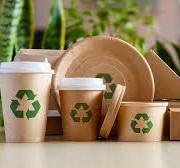The Importance of Environmental Packaging
Environmental packaging plays a crucial role in the sustainability efforts of businesses and the well-being of our planet. As awareness of environmental issues continues to grow, consumers are increasingly seeking products that are packaged responsibly and with minimal impact on the environment.
One of the key aspects of environmental packaging is the use of recyclable materials. Packaging made from materials such as paper, cardboard, glass, and certain plastics can be recycled, reducing the amount of waste that ends up in landfills. By choosing recyclable packaging, businesses can significantly decrease their carbon footprint and contribute to a more sustainable future.
Biodegradable packaging is another important aspect of environmental packaging. Biodegradable materials break down naturally over time, leaving behind little to no harmful residue. This type of packaging is especially beneficial for reducing plastic pollution in oceans and landfills, as it decomposes without causing long-term harm to the environment.
Furthermore, lightweight packaging designs can help reduce energy consumption during transportation and distribution. Lightweight materials require less fuel for shipping, leading to lower greenhouse gas emissions and overall energy savings. By optimising packaging designs for efficiency and eco-friendliness, businesses can make a significant impact on reducing their environmental footprint.
Innovations in sustainable packaging solutions continue to drive positive change in the industry. From plant-based plastics to compostable materials, companies are exploring new ways to package products without compromising on quality or functionality. By investing in environmentally friendly packaging options, businesses can demonstrate their commitment to sustainability and attract eco-conscious consumers.
In conclusion, environmental packaging is not just a trend but a necessity in today’s world. Businesses that prioritise sustainable packaging practices not only benefit the environment but also position themselves as responsible corporate citizens. By choosing eco-friendly packaging solutions, we can all contribute to preserving our planet for future generations.
Understanding Environmental Packaging: Key Questions and Insights
- What is environmental packaging and why is it important?
- How can businesses benefit from using environmentally friendly packaging?
- What are some examples of recyclable materials used in environmental packaging?
- Are biodegradable packaging materials better for the environment than traditional plastics?
- What innovations are being made in the field of sustainable packaging solutions?
What is environmental packaging and why is it important?
Environmental packaging refers to the use of sustainable materials and practices in the design and production of packaging for products. It is important because it helps reduce the environmental impact of packaging on our planet. By using recyclable, biodegradable, and lightweight materials, environmental packaging minimises waste generation, decreases carbon emissions, and conserves natural resources. Sustainable packaging also plays a crucial role in raising awareness about environmental issues and encouraging businesses to adopt eco-friendly practices. Overall, environmental packaging is essential for promoting a healthier planet and ensuring a more sustainable future for generations to come.
How can businesses benefit from using environmentally friendly packaging?
Businesses can benefit significantly from using environmentally friendly packaging in several ways. Firstly, by adopting sustainable packaging practices, companies can enhance their brand reputation and appeal to environmentally conscious consumers. This can lead to increased customer loyalty and support, as more people are actively seeking products packaged in an eco-friendly manner. Additionally, utilising environmentally friendly packaging can help businesses reduce their carbon footprint and overall environmental impact. By choosing recyclable or biodegradable materials, companies can demonstrate their commitment to sustainability and attract a wider customer base that values responsible business practices. Ultimately, investing in environmentally friendly packaging not only benefits the planet but also boosts business growth and competitiveness in a rapidly evolving market focused on sustainability.
What are some examples of recyclable materials used in environmental packaging?
When considering environmental packaging, it is essential to highlight the diverse range of recyclable materials that are commonly used in sustainable packaging solutions. Examples of recyclable materials include paper and cardboard, which are widely utilised for their biodegradable properties and ease of recycling. Glass is another environmentally friendly packaging material that can be recycled endlessly without losing its quality. Certain types of plastics, such as PET and HDPE, are also recyclable and commonly used in packaging for their durability and versatility. By incorporating these recyclable materials into environmental packaging practices, businesses can significantly reduce their environmental impact and contribute to a more sustainable future.
Are biodegradable packaging materials better for the environment than traditional plastics?
The question of whether biodegradable packaging materials are better for the environment than traditional plastics is a common one in discussions about sustainability. While biodegradable packaging offers benefits in terms of reduced waste and lower environmental impact during disposal, it is important to consider the full lifecycle of these materials. Biodegradable packaging can break down more easily in natural environments, potentially reducing harm to wildlife and ecosystems. However, the production process of some biodegradable materials may still have environmental consequences, such as increased energy consumption or use of chemicals. Therefore, while biodegradable packaging can be a step towards reducing plastic pollution, a holistic approach that considers factors like resource use, emissions, and end-of-life disposal is essential to determine its overall environmental impact compared to traditional plastics.
What innovations are being made in the field of sustainable packaging solutions?
In response to the frequently asked question about innovations in sustainable packaging solutions, the field is witnessing a surge of creative and eco-conscious developments. From advancements in plant-based plastics to the introduction of compostable materials, the industry is embracing new technologies to reduce environmental impact. Companies are exploring innovative approaches such as edible packaging, reusable packaging systems, and biodegradable alternatives to traditional plastics. These sustainable packaging solutions not only address consumer demands for eco-friendly options but also pave the way for a more sustainable future where packaging plays a pivotal role in reducing waste and preserving our planet’s resources.

